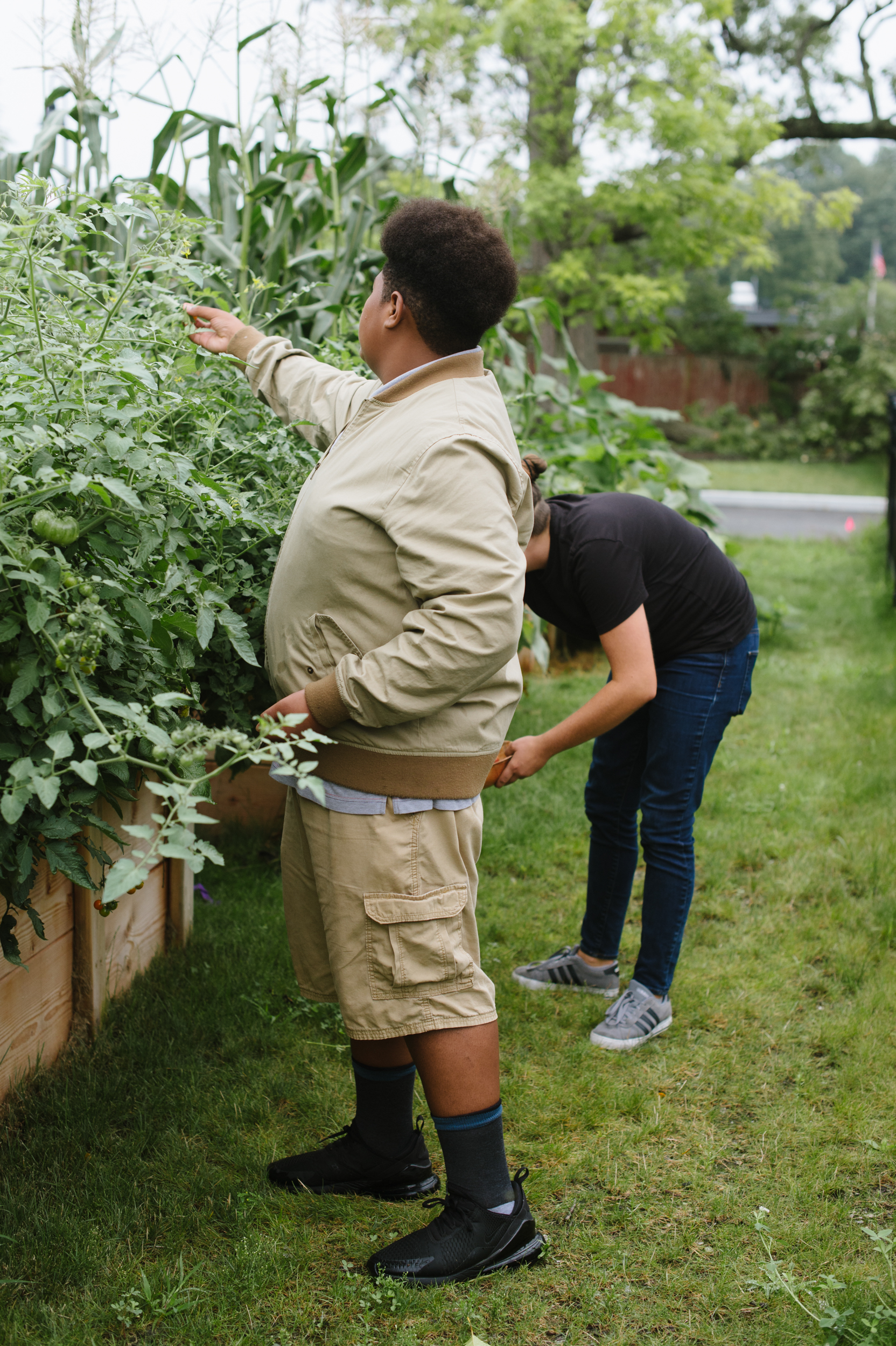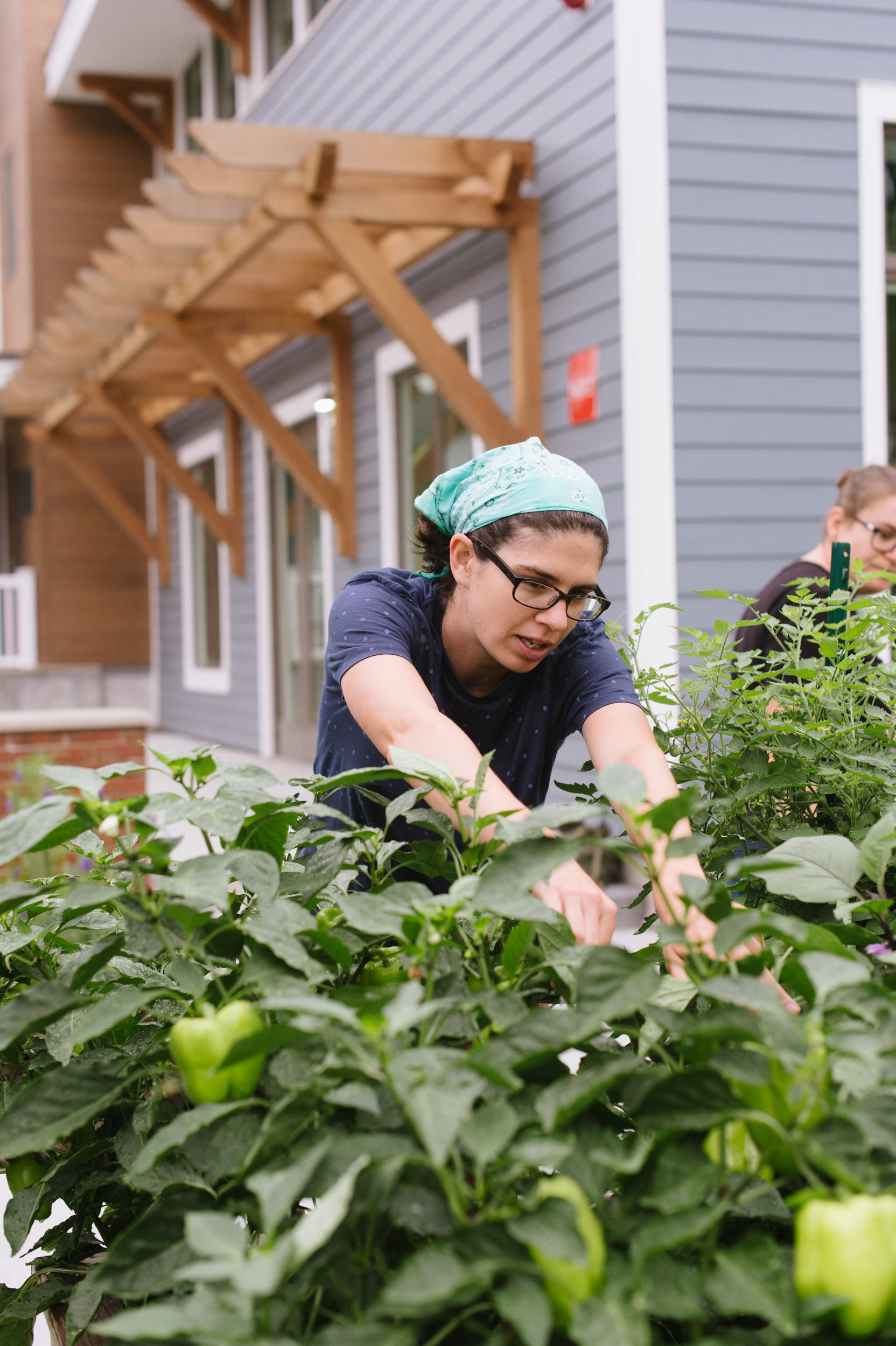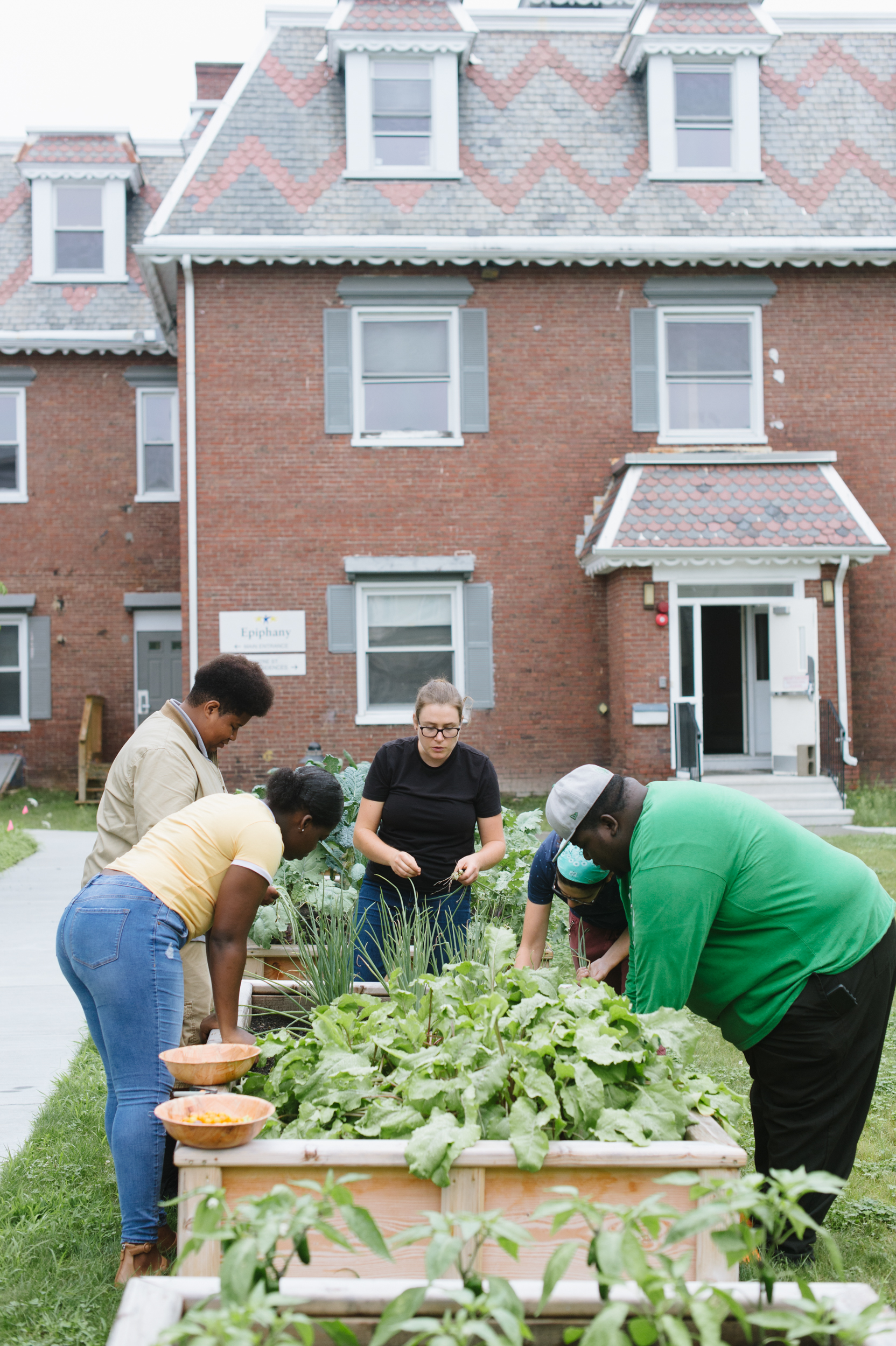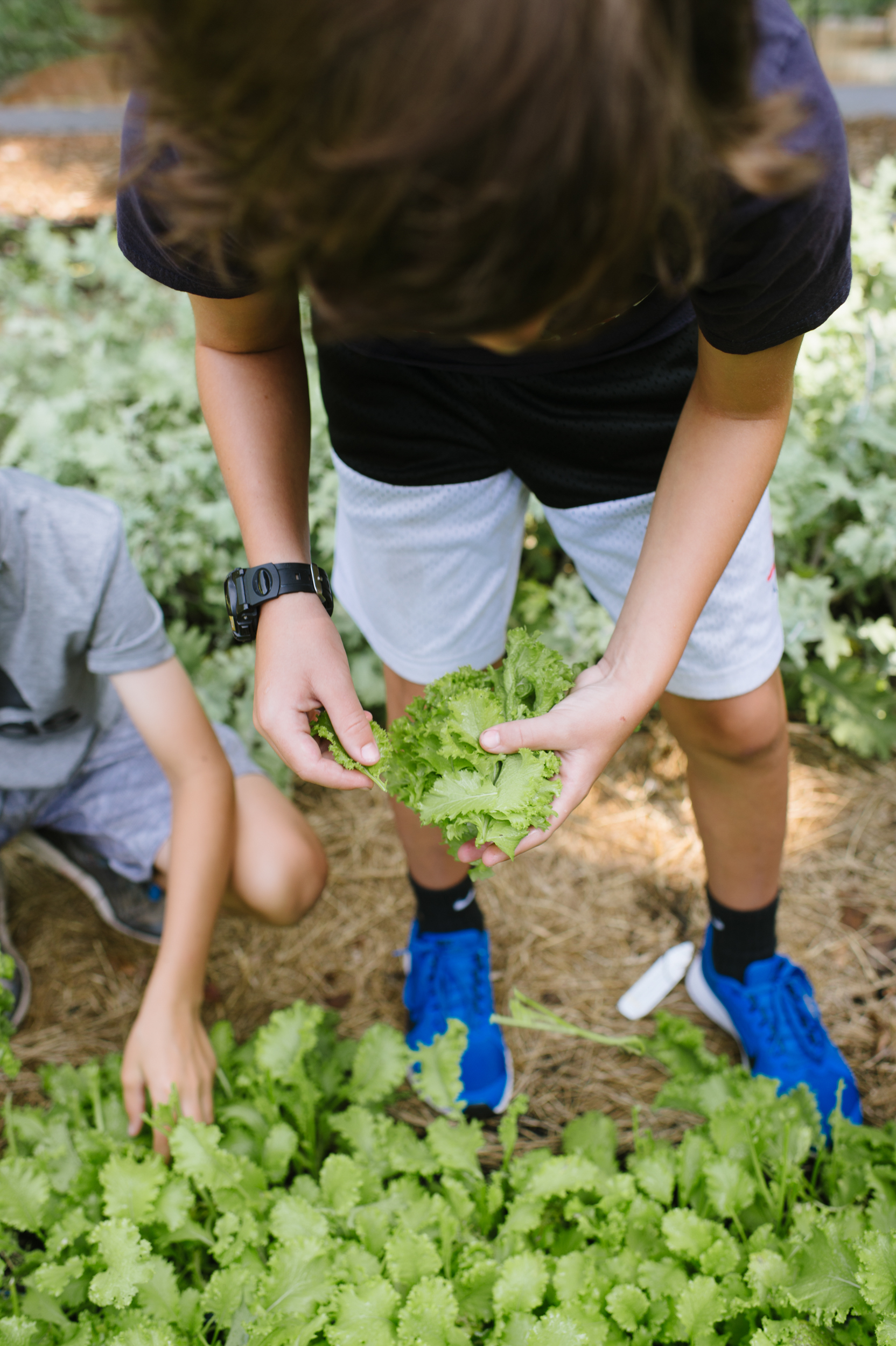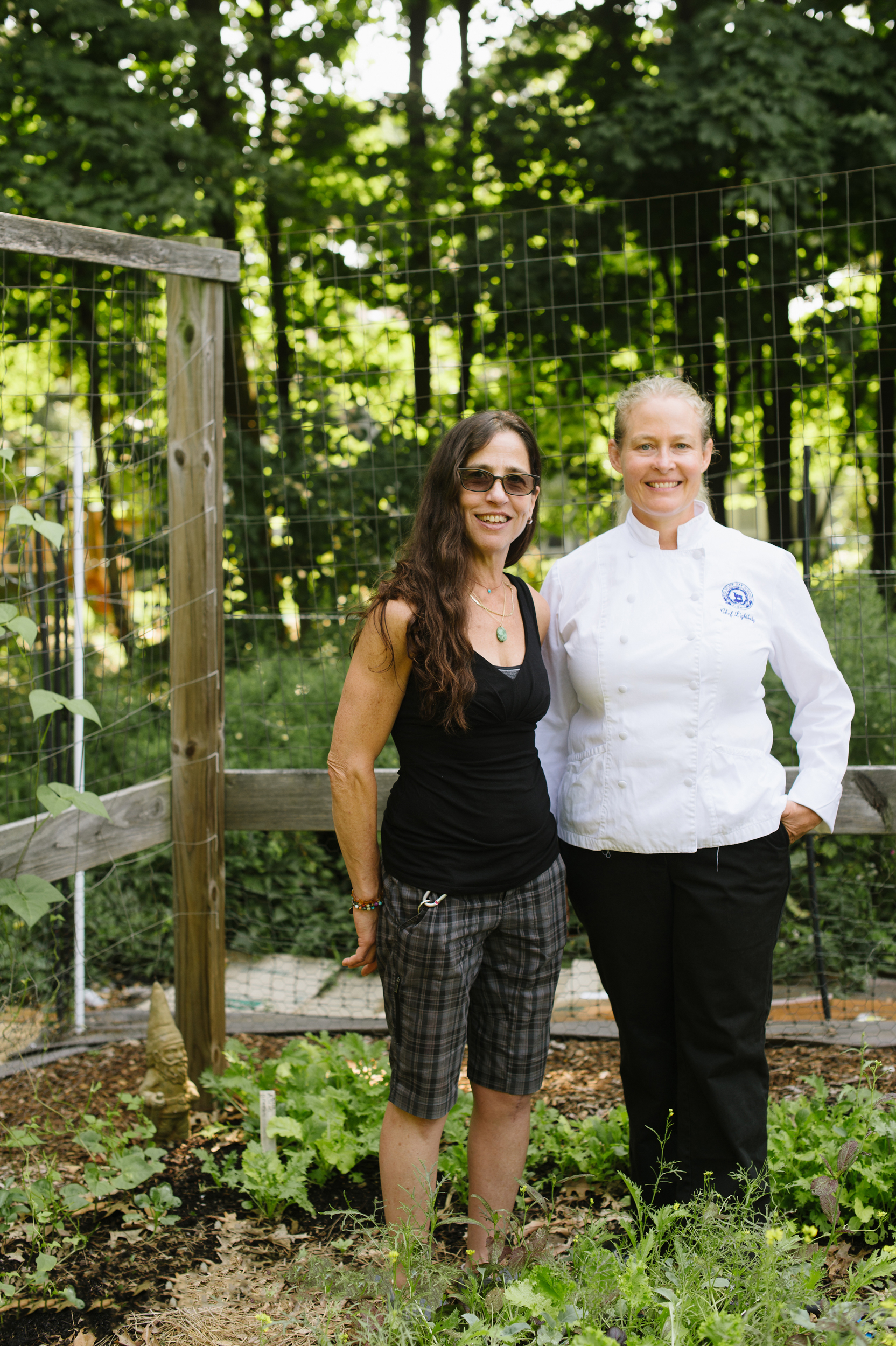Educating Gardens
Photos by Katie Noble
At Epiphany School’s Environmental Sustainability Celebration this past June, Steven, a fifth grader, explains that he and classmates Shamel, Nick and others planted snapdragons, bee balm, foxglove, echinacea and more in the school’s new pollinator garden. “We’re trying to attract Ruby-Throated Hummingbirds, which are very rare,” he says. “We thought it would be cool for the ecosystem.”
Other fifth graders, including Leianna and Blake, chose varieties to bring bees and butterflies, while additional students planted vegetable seedlings in the newly built raised garden beds. Batya, a sixth-grade member of the school’s cooking and gardening club, was happy to show off budding Red Russian and Dinosaur kale, spinach and mustard greens. “We measured the area and decided where to put all these plants,” she says. Tomatoes, broccoli, cabbage and more kale plants fill the other beds.
Epiphany’s gardens are on the grounds of its new Early Learning Center, a few blocks from the Dorchester middle school. Urban school gardens aren’t easy to come by, explains Ashleigh Inglis, a teacher and director of gardens and sustainability. “Most schools don’t have the space, staff or funding.” She acknowledges their good fortune, which includes a planned 1,000-square-foot greenhouse to be completed by late fall. Inglis says the multi-year plan is to have much of the available yard “covered in an edible landscape,” providing all kinds of learning opportunities and school projects.
About 15 miles away, in the idyllic town of Belmont, is Belmont Day School sitting on 11 suburban acres. Its garden is about 10 years old, managed for the last seven by Kathy Jo Solomon, an art teacher and coordinator of sustainability (as well as manager of other initiatives, including bee keeping, recycling and composting). She says one of the key benefits of the garden is that it helps “get kids outdoors and make a connection to nature.”
In many ways, Epiphany and Belmont Day are at opposite ends of the educational spectrum, from their locations and size to student economic backgrounds and institutional financial resources. Epiphany is an independent (tuition-free) middle school for approximately 90 students from economically disadvantaged families, most of whom live in Roxbury, Dorchester, Mattapan and Hyde Park. Funding comes from donations from individuals, foundations and corporations. Students identify as 70% Black (African American, Cape Verdean, Ethiopian, Eritrean, Haitian, Nigerian), 20% Latino (Puerto Rican, Dominican, Colombian) and 10% Multi-Racial/Other (Caucasian, Native American, Asian). About 35% speak English as a second language and 30% have special educational needs. Belmont Day is a private (tuition-based) school, pre-kindergarten through grade 8, with 274 students who come from 25 Greater Boston cities and towns; 35% identify as students of color and 20% of families receive financial aid.
Despite their differences, both are examples of schools (and there are likely dozens of others) actively incorporating garden education into their curriculums. The practice of garden-based learning isn’t new, but has gained momentum in the past 20 years coinciding with the focus on healthier eating and the value placed on locally grown and produced foods. According to Epiphany’s Inglis, garden-based education is an effective way for children to learn.
“Hands-on learning is a really equal playing field for kids with different learning abilities and languages and backgrounds,” she says. “The academic language can be so abstract and confusing, and using the outdoors can make these concepts concrete.” And she adds, “Staying inside learning about something outside just baffles me.”
The most obvious connections of gardening and growing food to education are in science, math, history and geography. At Epiphany, students learn about plants, pollination, food growing cycles, the effects of weather on how and where foods grow and how food relates to nutrition and health. Classes also cover big-picture issues, such as climate change, sustainability of food systems and honey bee colony collapse disorder. Studying the principles of garden design and then constructing an edible garden requires real-life problem solving. For example, students calculated the space needed to grow specific vegetables; estimated the cost of wood, soil and plants; and determined how many raised beds they could build within their budget. (The answer was 10.)
“There’s good math all over the place,” says Inglis. The history of agriculture and how foods, spices and ancient grains traveled the world are topics discussed in Social Studies. The garden also provides opportunities for more creative lessons, including descriptive writing, reading, art and meditation.
At Belmont Day, students are taught to be caring stewards of the environment as part of the school’s mission. Garden education starts in pre-K when the children dig up potatoes the prior year’s class planted. The 4-year-olds count and weigh the tubers before handing them over to chef Tara Lightbody to cook. First graders, in their study of Native American traditions, plant what’s called a Three Sisters Garden. Garden manager Solomon explains that the age-old practice of companion planting is demonstrated by the cooperative trio of corn, beans and squash: Tall corn stalks offer bean plants support, beans pull nitrogen from the air to fertilize the soil and large squash leaves shade the soil keeping it cool and moist. Some of the harvested corn is dried and ground into cornmeal for making cornbread, beans appear in salads and side dishes and pumpkins are cooked and puréed for the school’s popular pumpkin bread and pies.
Second-grade team teachers Tina Fox and Nancy Fell explain that the 7- and 8-year-olds use the garden as their year-round “outdoor classroom.” In science, students make observational sketches and grow plants; in math, they measure and plan the number of plants that can fit in the garden. The kids collect food labels, research where food comes from and how far it has to travel and learn what grows locally. The class holds a “Read for Seeds” fundraiser to benefit Concord’s Gaining Ground nonprofit organic farm, which grows food for hunger relief. Students get sponsors to pay for the pages they read and the money raised ($4,600 this past April) is used to buy seeds for the farm.
“The garden offers a wonderful opportunity for the kids to be part of something bigger than themselves,” says Fell. “They see how the garden feeds people and learn that not everyone has access to this kind of healthy food.” Throughout the year students study Changemakers, people who make a difference, she says. “They learn that they, too, can be Changemakers. The garden is a visual representation of that.”
Both schools emphasize the strong link between garden and kitchen. “It’s important to reflect what we do in the garden in the kitchen,” says Sue Bielamowicz, Epiphany’s chef and kitchen director, who provides students with three meals a day. When “Chef Sue” arrived at the school six years ago she introduced cooking from scratch and began purchasing more locally produced foods, including vegetables, fruit and breads. Some of the produce used in the kitchen has been grown by students and staff in nearby community vegetable plots; much of it has come from the Urban Farming Institute of Boston, a nonprofit that promotes urban farming, and Langwater Farm in Easton. This summer and early fall, she’s taken advantage of the bounty from Epiphany’s very own garden.
In order to “give kids food that they’ll eat and is also healthful,” Chef Sue serves vegetables in different preparations—on the salad bar and in chili, curry, fried rice and always-popular burritos—until the children are familiar with them. She also knows they’ll be more willing to try foods that they or their peers grow. The chef bakes kale chips (there’s no fryer in the kitchen), roasts broccoli and eggplant (tossing the latter with balsamic vinegar and honey) and adds puréed butternut squash to the cheese sauce for mac-and-cheese. Nothing is hidden, however. At the start of most meals, Chef Sue or chef Adotey (Tey) Plange explain the selections and which healthful and local ingredients are incorporated.
At Belmont Day, chef and kitchen manager Tara Lightbody says students are always excited about growing food. “They think: ‘I worked on it, I planted it, watered it, weeded around it,’ so it’s a lot about ownership and being invested in the process,” she says. Her philosophy is to serve a variety of fresh vegetables, fruits and whole grains so the students get the nutrition they need. Offering them a choice, she says, “You have less waste that way.” She and assistant chef Vladimir Hucko use garden produce in the lunchtime salad bar and for various menu items, such as butternut squash soup, steamed green beans, baked potatoes and roasted zucchini and summer squash. Because the school calendar and garden harvest don’t completely overlap, summer pickings are donated to Rosie’s Place, a women’s shelter in Boston.
Middle-schoolers participating in Belmont Day’s Edible Garden club work in the garden and then head into the kitchen to turn tomatoes into salsa, cucumbers into pickles and root vegetables into fritters. During summer break, Chef Lightbody runs two sessions of a week-long specialty camp called Seed to Table. At the end of the week, campers participate in a cook-off challenge: Each of the three teams makes an appetizer using mostly local ingredients. The day before, they visit the Boston Public Market and talk to local growers and producers. This year’s groups purchased ground beef, bacon, chicken, goat cheese, eggs and tomatoes for their recipes. During one week, the competing entries were Italian-style meatballs with homemade tomato sauce; herb-goat-cheese-stuffed dates wrapped in bacon; and Asian-style pineapple chicken and zucchini skewers. All the herbs and zucchini were picked from the school garden.
When children work in a garden and grow food, the experience is not only inspiring and educational but it provides them with valuable knowledge that will serve them well throughout their lives. Garden managers Inglis and Solomon know the importance of multi-sensory activities to foster learning. And both school chefs Bielamowicz and Lightbody say that when kids grow food it pushes them to become more adventurous eaters. Chef Sue sums it up, simply, this way: “The more they’re in the same space as fresh produce, the more it won’t feel foreign to them when it shows up on their plate.”
This story appeared in the Fall 2018 issue.







